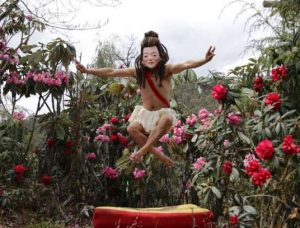
John Wm. Cannon recently retired as a lecturer and General Education Course Co-ordinator from Caritas Institute of Higher Education. Religion and Life was one of the courses he taught. He recently graduated with a Master of Buddhist Studies from the University of Hong Kong in 2011. He is presently working part time on the BDI Editorial Team.
Professor Y Karunadasa’s latest book, Early Buddhist Teachings. The Middle Position in Theory and Practice, is a welcome new addition to studies on doctrines and issues of early Buddhism and is a thorough defence of the middle path, the majjhima patipad?, which the Buddha is so assiduous in propagating. He is able to explain clearly and coherently the major concepts of early Buddhism and its place in religious discourse as a critical response to the major binary approaches in the Indian religious traditions of his time, sassatav?da (eternalism) and ucchedav?da (annihilationism).
In our interview, when Prof. Karunadasa was asked about his objective and reason for writing Early Buddhist Teachings he answered that there were at present not enough books available on early Buddhism and that some of these writers had assumed too much or misinterpreted the suttas. His aim was to write a readable introductory text to early Buddhist teachings which was “faithfully based on the original P?li suttas… to give an insight into the P?li suttas without going to the Abhidhamma and commentaries… [so that] early Buddhist teachings can be understood without going beyond the P?li suttas.”
Karunadasa extensively and insightfully covers most of the important concepts of early Buddhism which are shared between all Buddhist traditions although interpretations may vary: Four Noble Truths, Dependent Arising, Self/Non-Self, the mind and mental constructs, Noble Eightfold Path, Nibb?na. In his Preliminary Observations, Karunadasa outlines what Buddhism is as a religion, followed in the next chapter with the birth of Buddhism within the religious context of the times.
The reader is constantly reminded of the importance of the middle position in Buddhism: being in the middle between the two extremes of eternalism and annihilationism; the geographical heartland of Buddhism in the majjhima desa or middle region of North India; and the cosmological importance of the middle since the human realm is in the middle of the six realms of existence. “…only we humans who have the salutary atmosphere and the necessary wherewithal to follow the teachings of the Buddha, only we humans who can thus realize the final goal of Buddhism….true heaven is not up above but here below in this terrestrial world of human beings.” (p. 20)
Karunadasa thoroughly discusses the importance of morality which needs to be constantly cultivated and internalised in one’s spiritual trajectory along the Noble Eightfold Path to Nibb?na and how one’s system of morality should reflect our correct perception of the nature of reality resulting from understanding our world of sensory experiences. Morality not only affects the individual but society as well. My own good and that of others are interdependent and not distinct from each other. Selfish individualism and self-centredness must be uprooted. For the Buddha living a moral life is the linchpin of our samsaric existence, religious life and “whether one believes in a particular religion or not, whether one believes in survival or not, everyone should practice the moral life.” (p.99) Morality is the individual and society’s foundation. In his chapter on the Theory of Moral Life, Karunadasa does not fail to give a spirited response to criticisms of the early Buddhist ideal of Arhatship as being selfish and individualistic.
I especially like the chapter on the Pursuit of Happiness which is an effective counter to the misperception that Buddhism is pessimistic in outlook. There is a strong correlation between morality and happiness. Whatever is morally good naturally results in the agent(s) being happy and unhappiness results if one’s actions are morally unwholesome, akusala. As previously mentioned with morality, that the individual and others are inseparable, the same applies to happiness. Our own happiness is dependent on both the happiness others bring to us as well as our own actions that bring happiness into being for those around us.
I found Karunadasa’s discussion of nibb?na revealing and optimistic. Many people mistakenly see nibb?na, Buddhism’s highest goal, as something external to oneself, an external location which can be realised only after death. However, Karunadasa shows us that nibb?na “not only can be realized, but has to be realized in this very life.” (emphasis mine, p. 129)
There is a chapter towards the end of the book on how Buddhism perceives God(s) or an impersonal Godhead which is shared with other Buddhist traditions. Karunadasa includes here a quote by N?g?rjuna of the Madhyamikas in the later Mah?y?na period which repeats early Buddhism’s aloofness from the efficacy of gods in one’s spiritual quest and the importance of understanding Dependent Arising.
“We know the gods are false and have no concrete being
Therefore the wise man believes them not
The fate of the world depends on causes and conditions
Therefore the wise man may not rely on gods.” (p. 152)
Do not overlook the Appendix as it is a valuable collection of early Buddhism’s response to religious fundamentalism.
The book achieves the goals set by the author. The position of the teachings as being in the middle position in theory and practice is ably and convincingly elucidated. Karunadasa succinctly remarked to me that “ There is always a gap between theory and practice but it is best to be as near the ideal as possible.” (Emphasis mine).
Karunadasa’s use of P?li is impeccable as ever and used sparingly and effectively throughout the text, so as not to overwhelm general readers, while satisfying the needs of more scholarly readers. (I humbly pointed out one P?li error in the text which Prof. Karundadasa graciously appreciated my ‘sharp eyes’ and would correct). I heartily recommend Early Buddhist Teachings to all those who are interested in early Buddhism and is a welcome new addition to the current literature.
The book is presently being translated into Chinese to be published by the Centre of Buddhist Studies. Prof. Karunadasa’s next endeavour is to revise Buddhist Analysis of Mind originally published in 1967.
Dedicated to all sentient beings with mett?.
John Wm. Cannon
To obtain copies of this book, please contact:
http://www.buddhism.hku.hk/Publications.html – Centre for Buddhist Studies, HKU
Other publications from the Centre for Buddhist Studies, HKU:
Buddhist and Pali Studies in Honour of the Venerable Professor Kakkapalliye Anuruddha
Ed. KL Dhammajoti and Y Karunadasa
Entrance into the Supreme Doctrine: Skandhila’s Abhidarm?vat?ra
Bhikkhu KL Dhammajoti
A Guide to the Study of P?li: The Language of Therav?da Buddhism
K?kk?palliye Anuruddha Thera
Studies in P?li Commentarial Literature: Sources, Controversies and Insights
Toshiichi Endo











